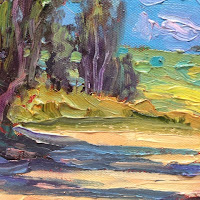 |
| Warmth of Summer, 16" x 20", oil on canvas |
I've talked with artists who love thick applications of color but in order to get the control they need revert to thinner applications. I think the reason Van Gogh used cloisonnism was to retain a sense of control while walking the tightrope of thick paint application. You can observe from his work that the emergence of the surrounding line is intermittent–the line is not uniformly thick nor visible around every form. This thick and thin, vanishing line is what gives Van Gogh's work form while still retaining a considerable degree of sophistication of texture. Van Gogh borrowed this look from the art of woodcut. Although I've been a printmaker for decades until now I haven't explored this promising technique.
In the accompanying painting I added cloisonnism by using a red acrylic marker to draw my motif on gessoed canvas. I then added a thin layer of Gamblin Galkyd tinted with Quinacridone Red. I added local color using brushes and palette knives leaving a ragged line of underpainting around each form. I modified the line by pushing the adjacent color around with a fan brush.
Of extreme interest was achieving a degree of success even though I was in a low energy cycle while painting. This safety net–a process that allows for a more relaxed approach–is very welcome. I can see evolving this technique until the line, though present, becomes less obtrusive. This is what I believe the Group of Seven did as the use of line at certain stages of their development is less evident in their work.
Brad Teare –September 2015



